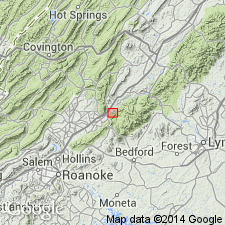
- Usage in publication:
-
- Waynesboro formation*
- Modifications:
-
- Named
- Dominant lithology:
-
- Sandstone
- Shale
- AAPG geologic province:
-
- Appalachian basin
Summary:
Named for town of Waynesboro, Franklin County, PA. Previously part of Shenandoah limestone. Type locality is ridge north of Waynesboro. Composed of siliceous, ripple-marked, purple shale and flaggy calcareous sandstone. Tends to be ironed stained. Flaggy sandstone and sandy shale at top of formation generally forms low ridge. Formation is about 600 feet thick. Is stratigraphically above the Tomstown dolomite and below the Elbrook limestone. Trilobite fragments suggests a Middle Cambrian age. Table of stratigraphic units and geologic map of South Mountain area is included in report.
Source: GNU records (USGS DDS-6; Reston GNULEX).

- Usage in publication:
-
- Waynesboro formation*
- Modifications:
-
- Age modified
- AAPG geologic province:
-
- Appalachian basin
Summary:
Aged changed to Early and Middle(?) Cambrian based on trilobites.
Source: GNU records (USGS DDS-6; Reston GNULEX).

- Usage in publication:
-
- Waynesboro formation*
- Modifications:
-
- Age modified
- AAPG geologic province:
-
- Appalachian basin
Summary:
Age changed to Early Cambrian based on trilobites.
Source: GNU records (USGS DDS-6; Reston GNULEX).

- Usage in publication:
-
- Waynesboro formation
- Modifications:
-
- Areal extent
- Dominant lithology:
-
- Sandstone
- Shale
- Limestone
- Dolomite
- AAPG geologic province:
-
- Appalachian basin
Summary:
Geographically extended to WV. Consists of assortment of red, purple, and green shale, thin slabby limestone, impure sandstone, and dolomite. Estimated thickness of 1000 feet. Main outcrop in Jefferson County. Stratigraphically above Tomstown dolomite and below Elbrook limestone. Age considered Early Cambrian.
Source: GNU records (USGS DDS-6; Reston GNULEX).

- Usage in publication:
-
- Waynesboro formation*
- Modifications:
-
- Areal extent
- Dominant lithology:
-
- Shale
- Siltstone
- Limestone
- AAPG geologic province:
-
- Appalachian basin
Summary:
Geographically extended to Virginia. Described in Elkton area, Rockingham County where it is about 1700 feet thick. Overlies Tomstown dolomite and underlies Elbrook dolomite. Consists of red and brown shale, calcareous shale and siltstone, and some limestone. Closely resembles Rome formation in character and stratigraphic position. Name Waynesboro is now used in Virginia as far south as Roanoke, VA, beyond which name Rome is used. Age is Early Cambrian.
Source: GNU records (USGS DDS-6; Reston GNULEX).

- Usage in publication:
-
- Waynesboro formation
- Modifications:
-
- Areal extent
- AAPG geologic province:
-
- Appalachian basin
Summary:
Geographically extended to Maryland. Many outcrops in Washington County but complete section not known; most complete section is east of Chewsville where formation is about 845 feet thick. Overlies Tomstown dolomite and underlies Elbrook limestone.
Source: GNU records (USGS DDS-6; Reston GNULEX).

- Usage in publication:
-
- Waynesboro formation
- Modifications:
-
- Age modified
- AAPG geologic province:
-
- Appalachian basin
Summary:
Age changed to Early and Middle Cambrian on stratigraphic column that accompanies WV State geologic map.
Source: GNU records (USGS DDS-6; Reston GNULEX).

- Usage in publication:
-
- Waynesboro Formation
- Modifications:
-
- Reference
- Overview
- AAPG geologic province:
-
- Appalachian basin
Summary:
Both the Rome and Waynesboro Formations (equivalent units) span the Lower-Middle Cambrian boundary, based on fossils collected throughout the Appalachian basin. Three sections of the Waynesboro Formation in the Buchanan 7.5-min quad., Botetourt Co., VA, were measured and described, and make up the composite section which serves as a reference section. Section 1 (Buchanan) is exposed along the northeast side of the CSX right-of-way, southeast of the site of the old depot, located beneath the U.S. Hwy 11 overpass into the town of Buchanan. Section 2 (Arcadia Bridge) is exposed along the southwest side of the CSX right-of-way near the bridge across the James River that takes County Road 614 to the town of Arcadia. Section 3 (Indian Rock) is exposed along both sides of the CSX right-of-way, southeast of the site of Indian Rock. Unit may divided into three sequences: 1)lower interbedded carbonate rocks and grayish red and green calcareous siltstones; 2) middle carbonate rocks bounded at top and bottom by two thick, massively bedded burrow-mottled dolomudstones; and 3) upper sequence of interbedded carbonate rocks and siltstones. Waynesboro is 350 m thick based on composite section, which includes contacts with the underlying Shady Dolomite and the overlying Elbrook Formation.
Source: GNU records (USGS DDS-6; Reston GNULEX).

- Usage in publication:
-
- Waynesboro Formation
- Modifications:
-
- Revised
- AAPG geologic province:
-
- Appalachian basin
Summary:
Revised the Waynesboro Formation in MD, PA and WV to include the (ascending) Red Run, Cavetown, and Chewsville Members. The Red Run Member consists of interbedded sandstone and sandy, dolomitic limestone (100 to 125 feet thick). The Cavetown Member consists of interbedded dolomite, dolomitic limestone, and a few siliciclastic beds (500 to 600 feet thick). The Chewsville Member consists of interbedded maroon shale, sandstone, dolomitic limestone, and dolomite (100 to 150 feet thick). The Waynesboro overlies the Tomstown Formation and underlies the Elbrook Formation. Age of the Waynesboro is considered Early Cambrian.
Source: GNU records (USGS DDS-6; Reston GNULEX).
For more information, please contact Nancy Stamm, Geologic Names Committee Secretary.
Asterisk (*) indicates published by U.S. Geological Survey authors.
"No current usage" (†) implies that a name has been abandoned or has fallen into disuse. Former usage and, if known, replacement name given in parentheses ( ).
Slash (/) indicates name conflicts with nomenclatural guidelines (CSN, 1933; ACSN, 1961, 1970; NACSN, 1983, 2005, 2021). May be explained within brackets ([ ]).

